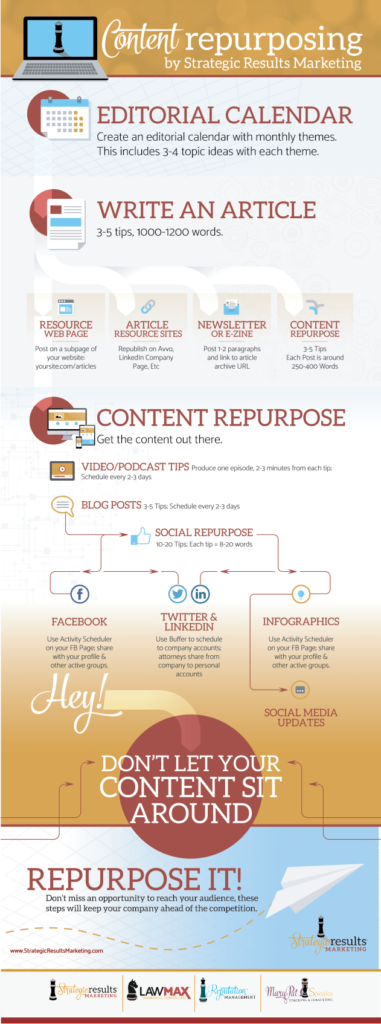When your marketing strategy requires you to produce high-quality content regularly, sometimes all your content needs is to be refreshed and revitalized.
Through content repurposing, you take something you’ve already created and turn it into something new! A blog post can become an infographic or a podcast can become a social media campaign. Voila!
The Australian Institute of Business has the following brilliant tips for exploring why businesses should repurpose content. This guide will also walk you through the many ways content repurposing is beneficial to you and your business by exploring these main points:
- Why content repurposing is a strategy you should use in your marketing
- How do you repurpose?
- What do you say?
- Where do you start?
Why Content Repurposing is a Strategy You Should Use in Your Marketing
Think about articles, blog posts, infographics, or podcasts that you’ve done in the past. Wouldn’t you like to find creative new ways of reinventing that content to attract a new audience or engage a new target market?
Your answer should be yes. Here’s how this strategy will amp up your marketing.
Saves Time and Money
We’ve all heard the saying “time is money” and this especially applies to the world of content creation. Repurposing your content allows you to produce more with the same amount of input while preserving quality.
High-quality content takes time and money to create. As a result, it’s critical to repurpose evergreen content when you can, rather than developing fresh content from scratch. This way, you get more value for your money. Furthermore, it saves you time, allowing you to focus on fresh marketing ideas and other elements of your organization.
Easy to Implement
Content repurposing is easier and faster to implement. Why? Because most of the information, images, and other elements are already there.
Instead of starting from scratch, simply change the format of the material, add information, images or take on a new perspective to reinforce your voice. You don’t have to completely redo the whole thing.
How Do you Repurpose Content?
Here’s a step-by-step guide we have meticulously compiled to show you the most efficient ways to repurpose your content.
Step One: Create an editorial calendar with monthly themes.
This should include around 3-4 topic ideas with each theme. Utilizing an editorial calendar is one of the best ways to strategize your content and allows you to produce more high-quality content in less time.
Step Two: Write an Article
Your article can be between 1000-1200 words in length with 3-5 tips to effectively explore your topic of choice.
After the article is published, you can increase visibility by posting 1-2 paragraphs to a Newsletter or E-zine, along with a link to the article archive URL. You can also republish your content to article resource sites including Avvo and LinkedIn Company page.
Step Three: Content Repurposing
It’s time to get your content out there. You can turn your 1200 word article into video or podcast tips. Produce one video 2-3 minutes for each tip and schedule it every 2-3 days.
You can also turn that formal article into a more casual and conversational blog post with 3-5 tips. These posts can also be scheduled every 2-3 days.
Social Media Repurposing
Twitter, Facebook, LinkedIn, and Instagram are powerful social media tools that can increase your visibility and awareness. Additionally, repurposing content for social media can be a fun way to increase engagement.
Instead of continually coming up with fresh ideas, look through your most popular articles. Take your original post’s subheadings, add some information under each, and create a new Twitter thread.
You may also use this method to create content for LinkedIn or Facebook. Instead of summarizing the entire blog content, why not expand on a single point? This will provide you with 8-10 social media updates from a single article.
Furthermore, using Instagram allows you to make your material more aesthetically appealing by adding media while conveying your message and getting your brand noticed.
What Do you Say?
Sharing the same content with the same audience may seem counterintuitive. However, the information doesn’t have to sound repetitive. It is vital to be as creative as possible so you don’t regurgitate the same information in the same way.
Use quotes, testimonials, offer guest contributions, interesting statistics, and take on a new perspective to flesh out your ideas.
Where do you start?
Begin by selecting content that is most relevant to your present objectives. Do you want to target a certain audience, expand your reach or cater to a new market? The ideal articles to repurpose are those that serve as a springboard to those objectives.
When you’re starting, choose evergreen content that you have more to say about. Implementing the editorial calendar as we mentioned above can help you come up with a list of popular subtopics, frequently asked questions, and related inquiries.
Lastly, examine your website’s metrics. Discover which articles are most popular and perform well in terms of criteria such as reach, organic visibility, and shares. These would be the most ideal materials for content repurposing.
Let’s Wrap Up
Content repurposing yields several benefits, including saving time and money, easy implementation, diversifying your content, and expanding your reach. It’s a marketing life-hack that you should take advantage of. It allows you to add value to your original content without the exhausting amount of effort it takes to create content from scratch.
When you’re ready to begin your content repurposing journey, take a look at our content repurposing infographic which sums up all the steps you need to effectively reach your audience and stay ahead of the competition.


